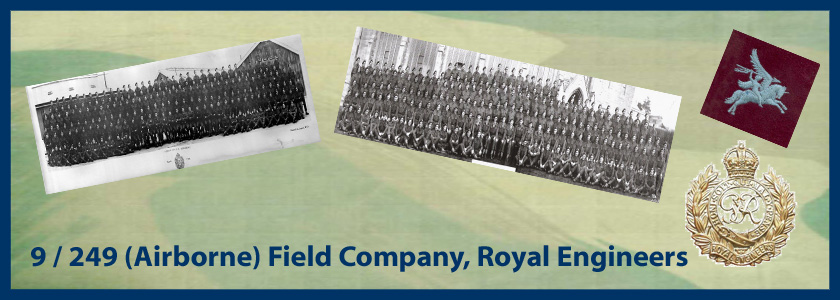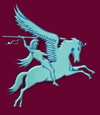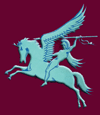[Affiliated Groups] [Events] [Links] [Guestbook] [Contact Us]
Intelligence Corps & FSS History...
9/249 Field Company (Airborne) Royal Engineers
6th Airborne Division:
22nd Independent Parachute Coy
1st Canadian Parachute Battalion
Royal Army Chaplains Department
Polish Independent Carpathian Rifle Brigade (SBSK)
History
The history of 9 Fd Coy, RE, dates back to October 1787 when it was raised in Chatham as the Chatham Coy. Up until the start of the Second World War it had already seen action in the Kaffir Wars in 1845, Boer Wars in 1900, and the First World War.
At the outbreak of war in September 1939, it was sent to France with 4 Div, later transferring to 48 Div. On its return to England from Dunkirk it remained with 48 Div until the December of 1941 when upon it was transferred to the 1 Air landing Brigade.
In May 1942, it was reorganised as 9 Field Company RE (Airborne) becoming the Engineer support for the newly formed 1st Air Landing Brigade. Interestingly, about one third of the Company were trained in the parachute role and the remainder were trained as gliderborne troops. Their first Airborne Operation was in Norway in 1942 where they were tasked to destroy a heavy water plant.
Operation FRESHMAN
On the 19th November 1942, two Halifaxes, towing two Horsa gliders, set off from an airfield in Scotland for southern Norway. Their objective was the Rjukan Heavy Water Plant which was connected with German research on the atomic bomb. The importance of the mission was such that all risks had to be taken. This was the first time that British gliders set out to attack the enemy.
Each glider carried fifteen sappers, all volunteers, under the command of Lieutenant Methven, G. M., and two pilots per glider. Their task was to destroy the objective, and the difficulties were great. In the first place, the towing of gliders was an art in which the crews had not as yet had much practice. Secondly, the tugs had to be adapted and their engines, having to pull the added weight of the glider behind, developed defects, particularly in the cooling system. Fortunately these and other troubles were discovered during the practice tows and were remedied. The greatest difficulty of all was that caused by the distance to be covered, some 400 miles, and the necessity for extremely accurate navigation over the mountainous district in which the objective lay.
On the morning of the attempt, there was thick cloud for most of the way, but clear skies and a good moon over the target area were promised. The two Halifaxes took off while it was still light and set course for Norway. Almost immediately the intercommunication system connecting the gliders and the tugs broke down. One Halifax kept low, seeking to fly beneath the cloud and then to gain height on nearing the Norwegian coast, where the pilot hoped for clear weather. What happened next is not exactly known, but at some moment the tug hit the side of a mountain, crashed, and all its crew were killed. The violence of the shock loosed the glider, which made a very heavy landing close by, killing and injuring several of its occupants.
The other Halifax was more fortunate. It flew high and approached the Norwegian coast at 10,000 feet. Here, as promised, the weather cleared, but it was found impossible to locate the landing zone. Though they were the best that could be got, the maps were exceedingly inaccurate, and the necessary pin-point landing could not therefore be obtained. The whole district was covered with snow which made the identification of objects on the ground even more difficult. The pilot of the Halifax made every effort to find the right spot, until, with petrol running low he was forced to turn for home. The glider was still at the end of the rope, but on crossing the coast the tug and glider ran into heavy cloud and icy conditions. The air became very bumpy and the two parted. The glider managed to land and crashed not very far from the other. The survivors of both gliders were captured and almost immediately fell into the hands of the Gestapo.
The twenty-three survivors of the two glider crashes were executed in accordance with the instructions of the Fuehrerbefehl (an order by Hitler requiring the execution of all soldiers engaged in commando operations). All seven crew members of the Halifax that was lost were killed in the crash.
North Africa, Sicily, and Italy
Throughout 1943 it saw action in North Africa, Sicily and Italy with the 1st Airborne Division.
On 9th July 1943 the Company, as part of the 1st Air landing Brigade, assisted in the capture of the Ponte Grande Bridge at Syracuse in Sicily. This was a particularly successful Operation for the Company fighting alongside the 1st Border Regiment and 2nd South Staffordshire Regiment. Both Infantry Battalions received the battle honour "Ponte Grande Bridge" which they wear on their colours; the Company was honoured by the presentation of the Velum Scroll by His Late Majesty King George VI to commemorate their part in the battle.
Operation MARKET GARDEN – Arnhem 1944
In September 1944 the Company, under command of Major J C Winchester RE, took part in Operation MARKET GARDEN. The Company emplaned on the morning of 17th September 1944 and, except for two gliders that crashed, landed safely at Arnhem. A Platoon of about 60 strong under the command of Capt Eric O' Callaghan took up positions in a Schoolhouse close to the bridge. With all their ammunition intact, they played a significant role in the defence of the bridge, one sapper having knocked out six or seven armoured vehicles with a Piat anti-tank gun. The platoon was used as the counter-attack force by Lt Col John Frost, the CO of 2 Para, and fought magnificently in the Infantry role.
During the evacuation from Arnhem, Major Winchester and three other men of the Company were ordered to mark with tape the route down to the riverbank, along which the Division was to evacuate. In his absence, command of the Company was handed to Captain George. As soon as their work on the riverbank was finished, the first men began to filter through and as Maj. Winchester had been the first officer on the scene, he assumed the responsibilities of beach master and organized the men into groups to be ferried across.
Unfortunately 9 Fd Coy took heavy casualties at Arnhem. Of the original Company, 215 All Ranks, only 57 men returned to the UK, the remainder being captured or killed.
The structure of 9 Fd Coy for Op. MARKET GARDEN was as follows:
Company Commander: Major John Winchester
No.1 Platoon: Captain Roger Binyon
No.2 Platoon: Captain E. C. O’Callaghan
No.3 Platoon: Captain M. Heggie
Maj. Winchester was recommended for the Distinguished Service Order for the battle at Arnhem, but this was lowered to the Military Cross:
On 19th September 1944, Major Winchester, Officer Commanding 9th Field Company, RE, sited and organised a defensive position for his Company and detachments of 1st and 4th Parachute Squadrons under command, in the North West corner of the bridgehead area held by 1st Airborne Division. This position was so well sited and organised that it instantly became the pivot of all counter-attacks upon the enemy in that sector. As a result of the enforced contraction of the defensive perimeter, this position inevitably became a front line zone. Not once during the critical period 19th to 25th September was an inch of ground given. In spite of heavy casualties the position was held against all attacks by the enemy, largely due to the untiring energy of and disregard of personal danger by Major Winchester. His inspiring leadership, cheerfulness and continuous personal bravery largely contributed towards the excellent and successful fight put up by the Royal Engineers in his sector right up to the end. He is recommended for an immediate reward of the DSO.
By September 1945 it was assigned to 6th Airborne Division.
Below is a group shot of 9 Field Company, RE (Airborne)NOTE: The above picture is rather large so you'll have to scroll around your screen!!



